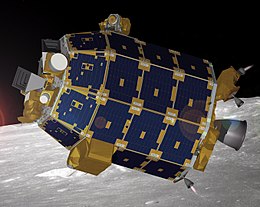Lunar Atmosphere and Dust Environment Explorer

Artist's depiction of LADEE in lunar orbit
|
|
| Mission type | Lunar atmospheric research |
|---|---|
| Operator | NASA |
| COSPAR ID | 2013-047A |
| SATCAT № | 39246 |
| Website | nasa |
| Mission duration | Primary mission: 100 days Extended mission: 28 days Total duration: 223 days |
| Spacecraft properties | |
| Bus | MCSB |
| Manufacturer | Ames Research Center |
| Launch mass | 383 kg (844 lb) |
| Dry mass | 248.2 kg (547 lb) |
| Payload mass | 49.6 kg (109 lb) |
| Dimensions | 1.85×1.85×2.37 m (6.1×6.1×7.8 ft) |
| Power | 295 watts |
| Start of mission | |
| Launch date | September 7, 2013, 03:27 UTC |
| Rocket | Minotaur V Flight 1 |
| Launch site | MARS LP-0B |
| Contractor | Orbital Sciences Corporation |
| End of mission | |
| Disposal | Deorbited |
| Decay date | April 18, 2014, ~04:30 UTC |
| Orbital parameters | |
| Reference system | Selenocentric |
| Periselene | 25–50 km (16–31 mi) |
| Aposelene | 60–80 km (37–50 mi) |
| Inclination | 157 degrees |
| Period | 111.5 to 116.5 minutes |
| Epoch | Planned (science phase) |
| Moon orbiter | |
| Orbital insertion | October 6, 2013, 10:57 UTC |
 Logotype of the mission |
|
The Lunar Atmosphere and Dust Environment Explorer (LADEE, pronounced /ˈlæd.iː/) was a NASA lunar exploration and technology demonstration mission. It was launched on a Minotaur V rocket from the Mid-Atlantic Regional Spaceport on September 7, 2013. During its seven-month mission, LADEE orbited around the Moon's equator, using its instruments to study the lunar exosphere and dust in the Moon's vicinity. Instruments included a dust detector, neutral mass spectrometer, and ultraviolet-visible spectrometer, as well as a technology demonstration consisting of a laser communications terminal. The mission ended on April 18, 2014, when the spacecraft's controllers intentionally crashed LADEE into the far side of the Moon, which, later, was determined to be near the eastern rim of Sundman V crater.
LADEE was announced during the presentation of NASA's FY09 budget in February 2008. It was initially planned to be launched with the Gravity Recovery and Interior Laboratory (GRAIL) satellites.
Mechanical tests including acoustic, vibration and shock tests were completed prior to full-scale thermal vacuum chamber testing at NASA's Ames Research Center in April 2013. During August 2013, LADEE underwent final balancing, fuelling and mounting on the launcher, and all pre-launch activities were complete by August 31, ready for the launch window which opened on September 6.
...
Wikipedia
